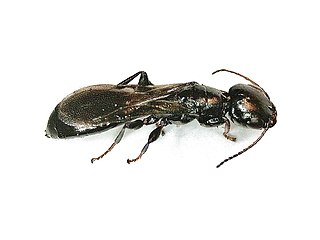
Enicocephalidae, also called unique-headed bugs and gnat bugs, are a family of around 300 species of the suborder Heteroptera. They are typically 4 mm (0.16 in) long, and found throughout the world. They have an elongated head, constricted in places, hence their head is 'unique'.

Psychodidae, also called drain flies, sink flies, filter flies, sewer flies, or sewer gnats, is a family of true flies. Some genera have short, hairy bodies and wings, giving them a "furry" moth-like appearance, hence one of their common names, moth flies. Members of the sub-family Phlebotominae, which are hematophagous, may be called sand flies in some countries, although this term is also used for other unrelated flies.

The Phlebotominae are a subfamily of the family Psychodidae. In several countries, their common name is sandfly, but that name is also applied to other flies. The Phlebotominae include many genera of blood-feeding (hematophagous) flies, including the primary vectors of leishmaniasis, bartonellosis and pappataci fever.

Compsocidae is a family of Psocodea belonging to the suborder Troctomorpha. The family comprises two extant species in two genera, both found in Mesoamerica. Compsocus elegans is found in Mexico and Central America, while Electrentomopsis variegata is found in Mexico. The antennae of each species have 13 or 14 segments. Two extinct genera, Burmacompsocus and Paraelectrentomopsis are known from the Cenomanian aged Burmese amber of Myanmar and Albian aged Spanish amber.

The Berothidae are a family of winged insects of the order Neuroptera. They are known commonly as the beaded lacewings. The family was first named by Anton Handlirsch in 1906. The family consists of 24 genera and 110 living species distributed discontinuously worldwide, mostly in tropical and subtropical regions. Numerous extinct species have also been described. Their ecology is poorly known, but in the species where larval stages have been documented, the larvae are predators of termites.

Kateretidae also known as short-winged flower beetles are a family of beetles in the superfamily Cucujoidea. There are 10 extant and 4 extinct genera, and at least 40 described species. They are found worldwide except in New Zealand. Adults are anthophagous, feeding on flowers, while the larvae are spermatophagous inside the flower corolla.
Raptorapax is an extinct genus of rhachiberothid which existed in what is now Lebanon during the early Cretaceous period. It was named by Julian F. Petrulevicius, Dany Azar and André Nel in 2010, and the type species is Raptorapax terribilissima. It was found in Lebanese amber.
Prionoglarididae is a family of the order Psocodea that are barklice characterized by the reduction or simplification of the lacinia in adults and the specialised form of the male genitalia. It contains the only known genus of animals, Neotrogla, where females possess a penis-like organ and take on typical male sex roles.

The Bethylidae are a family of aculeate wasps in the superfamily Chrysidoidea. As a family, their biology ranges between parasitoid wasps and hunting wasps.

Chelonariidae or turtle beetles is a family of beetles in the superfamily Byrrhoidea. It was described by Blanchard in 1845. There are 3 genera with around 300 described species. Little is known of their ecology, though it seems they are associated with the roots of orchids and the nests of ants and termites. Their exoskeletons are heavily sclerotised and their limbs can be effectively retracted into their bodies due to the presence of socket-like cavities. Adult specimens have seed-shaped bodies that are typically colored brown or black with lighter patches.

Spathiopterygidae is an extinct family of small parasitic wasps, known from the Cretaceous of Laurasia and Northern Gondwana. They are suggested to be members of Diaprioidea, in part due to their similarly reduced wing venation. Some members of the group reduced or lost the hindwings entirely.

Chresmoda is an extinct genus of insects within the family Chresmodidae.
Electropodagrion is an extinct species of damselfly in the family Megapodagrionidae known from a fossil found in Europe. The genus contains a single described species, Electropodagrion szwedoi.
Microphorites is an extinct genus of flies in the family Dolichopodidae.
Electrentomidae is an extinct family of barklice, booklice, and parasitic lice in the order Psocodea. There are about six genera and seven described species in Electrentomidae. The family was synonymsed with the extant family Manicapsocidae in 2003 without discussion, with a prior proposal in 1972, but Azar et al., 2017, stated that "we consider herein [Electrentomidae and Manicapsocidae] apart, because a cladistic phylogenetic analysis is needed prior to taking such important decision for these groups."
2015 in paleoentomology is a list of new fossil insect taxa that were described during the year 2016, as well as other significant discoveries and events related to paleoentomology that were scheduled to occur during the year.
Manicapsocidae is a family of Psocodea. It contains 8 extant species in 4 genera, with most of the species being found in the Neotropics and one species in the Afrotropics. The extinct family Electrentomidae has been suggested as a synonym of this family, though this has been considered premature by other scholars in the absence of cladistic analysis. Confirmed fossil species of the family are nearly as numerous as living ones, extending back to the mid-Cretaceous.
Archaeatropidae is an extinct family of Psocoptera in the suborder Trogiomorpha.
Lophioneurida is an extinct order of Thysanoptera, dating from the Carboniferous to the Cretaceous. It is likely paraphyletic, with modern thrips having evolved from members of the group.

Rohrthrips is a fossil genus of thrips in the family Phlaeothripidae.










